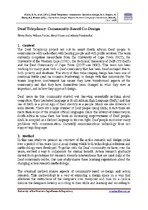| dc.contributor.author | Blake, Edwin H. | |
| dc.contributor.author | Tucker, William David | |
| dc.contributor.author | Glaser, Meryl | |
| dc.contributor.author | Freudenthal, Adinda | |
| dc.date.accessioned | 2013-11-20T10:55:12Z | |
| dc.date.available | 2013-11-20T10:55:12Z | |
| dc.date.issued | 2011 | |
| dc.identifier.citation | Blake, E. H., et al. (2011). Deaf Telephony: community-based co-design. In Y. Rogers, H. Sharp, & J. Preece (eds.), Interaction Design: Beyond Human-Computer Interaction, Interaction. http://www.id-book.com/casestudy_11-1.php | en_US |
| dc.identifier.isbn | 978-0470665763 | |
| dc.identifier.uri | http://hdl.handle.net/10566/844 | |
| dc.identifier.uri | http://www.id-book.com/downloads/casestudy_11point1.pdf | |
| dc.description.abstract | The process of community-based co-design is one that explores various solution configurations in a multi-dimensional design space whose axes are the different dimensions of requirements and the various dimensions of designer skills and technological capabilities. The bits of this space that one can ‘see’ are determined by one's knowledge of the user needs and one's own skills. Co-design is a way of exploring that space in a way that alleviates the myopia of one's own viewpoint and bias. As one traverses this space one traces a trajectory according to one’s skills and learning and according to the users’ expressed requirements and their learning. | en_US |
| dc.description.sponsorship | SANPAD, Telkom, Cisco, Aria Technologies, THRIP | en_US |
| dc.language.iso | en | en_US |
| dc.publisher | Wiley | en_US |
| dc.rights | This is the author postprint version of a casestudy published by Wiley. Readers may make use of the material providing due attribution is given. | |
| dc.subject | Community-centered design | en_US |
| dc.subject | Deaf telephony | en_US |
| dc.title | Deaf telephony: community-based co-design (case study) | en_US |
| dc.type | Other | en_US |
| dc.privacy.showsubmitter | FALSE | |
| dc.status.ispeerreviewed | TRUE | |

